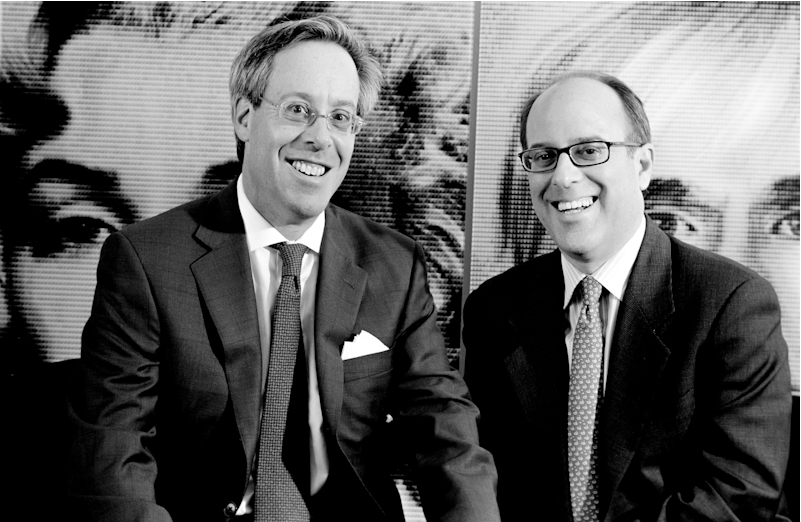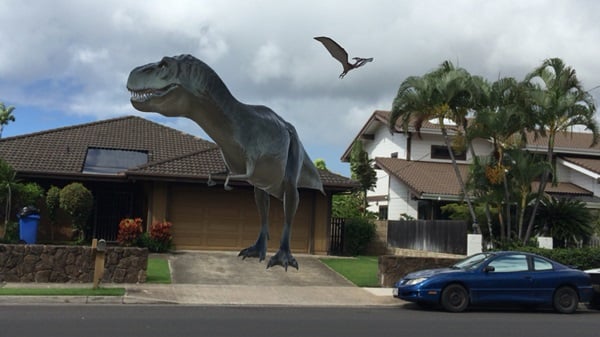Art & Exhibitions
On the Case: The Law on Augmented Reality and Museums
There is nothing virtual about being sued.

There is nothing virtual about being sued.

Charles and Thomas Danziger


T-Rex in Your Neighborhood.
Photo credit: Immersive Worlds, LLC.
A few of our more tech-savvy museum clients have recently been exploring whether and how to make some of their exhibits come alive by using exciting new “augmented reality” (AR) technology. At the same time, they have been grappling with cutting-edge legal issues involved in this new technology—which is where we come in.
In the interest of allaying fears and providing a brief legal road map on AR, here are a few typical questions we have received thus far.
THE TECHNOLOGY
Q: What is augmented reality and how are museums currently using it?
A: AR is the use of technology to view the physical world overlaid with 3D animation, video, sound or other virtual components to allow the viewer to see both the real world and a virtual augmentation of it. Using AR, a museum visitor has the illusion that the real world is actually interacting with a digital world.
AR creates extraordinary possibilities for educating and enthralling museumgoers. For instance, the Smithsonian National Museum of Natural History now uses it in its “Skin & Bones” app to give flesh to extinct animals, and the Chicago History Museum uses it to lay historical images over a live-streaming video of the bustling modern metropolis. In addition, the Van Gogh Museum Antwerp uses it to digitally reconstruct paintings. The possibilities for museums and other cultural institutions appear to be endless.
According to Mark Loughridge, a creative lead for Immersive Worlds, which makes immersive content for clients who want to step into augmented reality: “Most people who have heard of AR still think of text and icons overlaid on top of a view of the real world. This approach can feel cluttered, annoying, and devoid of the emotional epiphanies that we all care about. To my mind, the more exciting type of AR for museums is with 3D animated objects integrated into the real world to give viewers the visceral surprise; for example, ‘Oh my gosh, there are dinosaurs walking around the museum!’”
COPYRIGHT
Q: If we augment a painting—such as by overlaying it with video and sound—do we need permission from the painting’s copyright owner?
A: Maybe. The augmented work is arguably derivative of the original work, so it may require a license from the painting’s copyright holder. This is because the US Copyright Act gives the copyright owner the exclusive right “to prepare derivative works based upon the copyrighted work.” However, this “derivative work” license would not be necessary if the painting is out of copyright (such as in the case of a work by Van Gogh) or if the augmented version constitutes “fair use” of the original work.One problem here is that “fair use” is a gray area, and, in the case of AR, involves balancing a number of different factors, including the purpose and character of the augmentation, the nature of the underlying copyrighted work, and the effect of the augmentation upon the copyrighted work’s potential market.
As a practical matter, if a museum charges its visitors for an augmented reality experience without securing proper permission from the copyright holders of the underlying works, the museum is likely to hear from the copyright holders—or their attorneys.
Q: Are there many legal cases involving augmented reality?
A: Not yet. That said, one instructive case in this area is the 2002 Federal case Sherwood 48 Associates v. Sony Corp of America, where Sony digitally substituted advertising billboards on Times Square buildings to make scenes for the 2002 movie “Spider-Man.” The plaintiffs – owners of three buildings involved – argued that the substitution violated their trademarks, in part by raising confusion concerning their buildings’ association with the substituted ads. The Federal court disagreed with that argument, finding that artists may digitally modify nonpermanent advertisements if the changes are mainly to serve creative means.
Significantly, however, the Sony case did not involve the digital modification of copyrighted artworks, so it remains to be seen how courts will view AR within the context of art.
TRADEMARK
Q: Does the Sony decision mean that I cannot be liable for trademark infringement when using AR?
A: No. If you superimpose an image over a logo or other trademark and, in doing so, you damage the mark, you could be at risk. In AR trademark disputes, a court might balance the rights of the trademark owner with the First Amendment right to free expression.
MORAL RIGHTS
Q: If I digitally alter art, could I be liable for violating the artist’s moral rights?
A: Possibly. The Federal moral rights law, called the Visual Artists Rights Act of 1990 (or “VARA”), grants artists, among other things, the right to prevent distortion, mutilation, or modification of their works that would prejudice the author’s honor or reputation – but it remains to be seen whether AR constitutes distortion, mutilation, or modification under this law.
PERSONAL INJURY
Q: What happens if museum visitors are so distracted by the AR experience that they fall and injure themselves?
A: There could be liability—either on the part of the museum or the maker of the technology, or both. Given our legal system, there are probably personal injury lawyers waiting in the lobbies of museums today for just this sort of accident to happen.
RIGHT OF PUBLICITY
Q: Are there risks to making an unauthorized 3D digital likeness of someone famous and using it to promote my exhibition?
A: Yes, since misappropriating a likeness for commercial value could violate the celebrity’s right of publicity. One example of an AR version of a celebrity is James May (a host of the popular BBC show “Top Gear”) appearing as a digital museum guide in an app developed by the Science Museum in London.
RIGHT TO PRIVACY
Q: Since AR sometimes involves using “smart glasses” to record everything a user sees and hears in the physical world – and in some cases could even allow viewers to access personal data about bystanders by using facial recognition technology to identify them – is AR by definition an invasion of privacy?
A: Not necessarily, since courts typically consider it unreasonable to expect privacy when one is out in public. Nonetheless, to lower the risk of violating the rights of privacy, a museum may, for example, obtain the consent of bystanders or design a system that securely stores recorded data only as long as necessary and then disposes of it.
CONCLUSION
AR can be viewed as a form of “input” (such as recordings of people, copyrighted images, trademarks, etc.) and “output” (such as projecting altered images of copyrighted works). But in both the input and output, a museum working with AR would be wise to clear any necessary rights to avoid legal liability.
After all, there is nothing virtual about being sued.

Thomas and Charles Danziger are New York–based art lawyers who represent collectors, dealers, banks, auction houses, and others in the art community. For more information, visit www.danziger.com. Their column “On The Case” will appear periodically on artnet News. Photo: Kate Simon.